

| Note please: the images of the capitals and piers of the cloister are arranged in clockwise order from the northwest corner. The order of the galleries is thus: north, east, south, and west. | ||
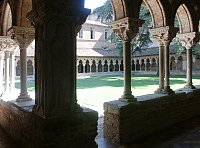
|
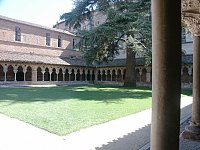
|
Northwest corner, looking southeastThe Church of St. Pierre is on the south side of the cloister. Its tall nave wall can be seen across the cloister. |
Left and center: St. Andrew; right: St. PhilipThese are two of the eight almost life-size figures which occupy the corner piers of the galleries. (Two other pier figures are on the central piers of galleries.) Like the others, these are flat figures in low relief, standing between columns and under arches inscribed with their names. Some stand on inclines or stairs, bare-footed or with shoes/sandals; their hands are always fully shown. The bodies are frontal and all but one have heads in partial profile with frontal eyes. The drapery folds are stylized as is the hair, imaginatively varied, often in repeated linear designs. Andrew's hair here is especially interesting. Parallel striations are used to depict it, as well as the beard and mustache, and the curls of his hair and beard end in a decorative twisting spiral. | ||

|
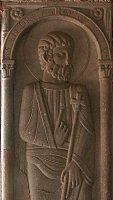
|

|

|
Foliate capital with curling vine leavesThere are more than a dozen capitals which depict various kinds of foliage. The foliage takes the form of acanthus leaves, palm fronds, vines or small leaves. Sometimes these capitals have flowers or fruit and occasionally they are inhabited with living creatures. Other categories of capitals include those with animals (especially birds), those primarily symbolic, and historiated capitals--those illustrating stories from the Bible or from the saints' lives. | |
Two faces of the St. Martin capital (below)The biography of St. Martin of Tours by Sulpitius Severus records this now famous event: ". . . in the middle of winter, a winter which had shown itself more severe than ordinary, so that the extreme cold was proving fatal to many, he [Martin] happened to meet at the gate of the city of Amiens a poor man destitute of clothing. He was entreating those that passed by to have compassion upon him, but all passed the wretched man without notice, when Martin, that man full of God, recognized that a being to whom others showed no pity, was, in that respect, left to him. Yet, what should he do? He had nothing except the cloak in which he was clad, for he had already parted with the rest of his garments for similar purposes. Taking, therefore, his sword with which he was girt, he divided his cloak into two equal parts, and gave one part to the poor man, while he again clothed himself with the remainder. . . . In the following night, when Martin had resigned himself to sleep, he had a vision of Christ arrayed in that part of his cloak with which he had clothed the poor man. . . .Ere long, he heard Jesus saying with a clear voice to the multitude of angels standing round -- 'Martin, who is still but a catechumen, clothed me with this robe.' The Lord, truly mindful of his own words (who had said when on earth -- 'Inasmuch as ye have done these things to one of the least of these, ye have done them unto me'), declared that he himself had been clothed in that poor man; and to confirm the testimony he bore to so good a deed, he condescended to show him himself in that very dress which the poor man had received" (Chapter III. See SULPITIUS SEVERUS ON THE LIFE OF ST. MARTIN ).West face of the capital: St. Martin dividing his cloak with a beggar | ||
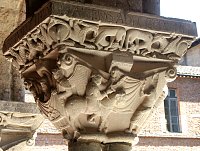
|
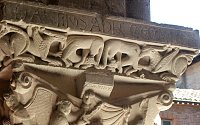
|
This balanced capital depicts the saint, a soldier on a horse, and the slender beggar on the right holding the cloak gracefully between them. Martin's name is inscribed above the cloak and on the abacus. The abacus is inhabited by griffons and other fantastic creatures. |
North face: St. Martin's vision of ChristJesus stands here in the center holding a more stylized and elegant version of St. Martin's cloak. Angels flank him. Like many of the capitals in the cloister, this one shows the importance of a symmetrical arrangement of figures. The compositions often reflect the importance of design to the sculptor. |
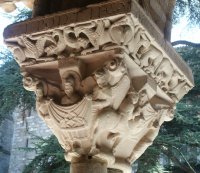
| |
Abacus with angels holding medallionsOne of the medallion contains a lamb--the agnus dei, or symbol for Christ. Like other capitals, this one illustrates the survival of earlier Corinthian forms of the capital. | ||

|
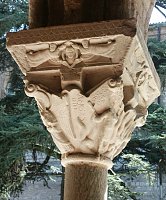
|
Hebrews in the Fiery FurnaceObvious flames occupy the centers of the faces of the capital while figures stand on the corners--the three Hebrews on three and an angel on the fourth. Their arms are raised in the "orant" position--an early Christian method of representing praying; the specific figures are identified by inscriptions. |
Works Consulted or Quoted:
Meyer Schapiro. The Sculpture of Moissac. NY: Braziller, 1985.
M. Alison Stones. Extensive medieval website.
 Go to Moissac Index.
Go to Moissac Index.
 Click here to return to index of art historical sites.
Click here to return to index of art historical sites.
 Click here to return to index of artists and architects.
Click here to return to index of artists and architects.
 Click here to return to chronological index.
Click here to return to chronological index.
 Click here to see the home page of Bluffton University.
Click here to see the home page of Bluffton University.

